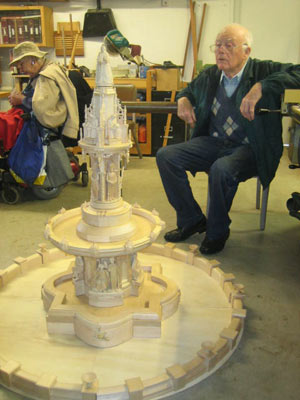A Monumental Miniature Fountain
Scottish Landmark Captured in Wood
While rain drummed a tattoo on the roof, friendly banter among members of the Santa Barbara-Goleta Chapter of the California Carvers Guild warmed the spacious workshop where the woodworkers gathered weekly. This particular Monday, however, an undercurrent of respect was also audible: Despite the wet threat, Bob McKay had kept his word to assemble, for the first time for the chapter, his recently carved masterpiece-an elaborate, four-foot-high basswood replica of a 19th Century British historical fountain.
Cameras flashed and compliments flowed like the River Clyde in McKay’s hometown of Glasgow. At 82, the ruddy-faced Scotsman quietly answered questions in a thick brogue unaltered by living in Santa Barbara the past 20 years, and modestly dismissed the kudos. “I never thought anybody would be terrible interested, to tell the truth,” he said.
Between Adult Education’s creative woodworking classes at Wake Center and the carvers’ Goleta workshop, hosted by the Mulberry family, McKay invested three years in fashioning a wooden miniature of what is thought to be the world’s largest terracotta fountain. Called Doulton Fountain after the donor, the commemorative gift celebrated Queen Victoria’s 1887 Golden Jubilee and the British Empire over which she ruled. Her statue crowns the original 46-foot-tall structure planted in one of modern Glasgow’s riverside parks.

Faithful to the last ornamental detail, Victoria Regina also tops McKay’s tiered wooden version. The Glaswegian, as Glasgow natives are known, created his replica double fountain in Goleta from hundreds of photographs he took during annual visits to Glasgow. “I go back to practice my accent,” he quipped, though he admitted visiting relatives in the city, too.
He also has many fond memories of spending his youth and a satisfying accounting career in Glasgow, though he saw changes that saddened him as the city lost its industrial base. McKay recalled he regularly walked past the queen and her sculpted minions on his way to work, noting the deterioration of the edifice and scandalous amounts of vandalism. By the 1960s the fountain had ceased to function.
In 2004, however, the city made restoration of Doulton Fountain one of the goals, and a symbol, of the East End area’s urban renewal. The massive structure was dismantled, relocated, thoroughly cleaned; broken or missing pieces were repaired or replaced, and the water was made to flow again. This renovation, which cost millions of dollars, surprised McKay on one of his visits and led to his documentation of the changes, though he said he was not preparing to capture its imperial splendor in wood.
He had been enrolled in Rica Coulter’s Creative Wood Sculpture course since 1997, carving Disney figures and other types of cultural icons. “Bob was very good at caricatures,” recalled Coulter, who has taught the Adult Ed class for the past 39 years.
“He’s very meticulous, a great detail man,’ added her husband, Keith, who described his classroom role as “teaching assistant.” Both remembered that when McKay talked to them about making a miniature of the Glasgow fountain he already had a scrapbook filled with images of the restored red-earth original.
“I wanted to do something challenging,” the sculptor explained with characteristic understatement. He found support as well as new tools for the fountain project at Wake Center, where he also had first met members of the carvers’ guild.
For easier handling, McKay designed his fountain as five units that stack atop each other. A low wall dotted with shallow urns rings the circular base, which will eventually hold a Plexiglas sheet to represent water; a column with four groups of figures in three-dimensional relief rises above the large basin. These groups represented Australia, Canada, India, and South Africa, which in 1887 were either colonies or only partially independent of the British crown.
On a pedestal above the colonies, four representatives of the empire’s military might stand gazing over a smaller basin lined with lion-headed waterspouts. Working at a scale of roughly one inch to one foot, McKay carefully carved the statues of a Royal Navy sailor, a Black Watch Highlander, a Grenadier Guardsman, and one of the Royal Irish Fusiliers. “They all had whiskers, too,” he noted wryly.
Four women water-bearers kneel on a platform over the soldiers, pouring water from their vessels into the small basin. Queen Victoria, complete with orb and scepter, forms the pinnacle above the women.
McKay still has to varnish the basswood, which he chose because of its suitability for detailed carving, but no water will flow through the fountain. He has no plan to show it publicly once it is completed; the miniature will probably go to his family in Glasgow next year, he said.
That would be understandable but disappointing to many of McKay’s American friends and teachers. “It’s beautiful and should be shown,” said Rica Coulter.



